Sultanahmet
Sultanahmet is a prominent district located in the historic peninsula of Istanbul and stands as one of the city's most important tourist centers. The area boasts a rich history that spans from the Byzantine Empire to the Ottoman Empire. Sultanahmet Square, known as the Hippodrome during the Byzantine era, was a crucial venue for imperial races, ceremonies, and public entertainment. Today, remnants from that period, such as the Obelisk of Theodosius and the Serpent Column, can still be seen in the square, offering a glimpse into its ancient past.
During the Ottoman Empire, the construction of the Sultanahmet Mosque marked a new era for the district. Built between 1609 and 1616 by the order of Sultan Ahmed I and designed by architect Sedefkâr Mehmed Ağa, the mosque is renowned worldwide for its striking blue tiles and six minarets, earning it the nickname "Blue Mosque." Directly opposite the mosque lies Hagia Sophia, a structure built during the Byzantine period, later converted into a mosque by the Ottomans, and now serving as a museum. These two iconic structures underscore Sultanahmet's cultural and religious significance.
Throughout history, Sultanahmet has carried the traces of various civilizations, becoming one of the central points of Istanbul's cultural fabric. The area is home to many significant historical buildings, including the Topkapi Palace, the Basilica Cistern, and the Museum of Turkish and Islamic Arts. These landmarks offer visitors a journey through time, from the Byzantine and Roman periods to the Ottoman era and beyond. Sultanahmet remains a must-see destination for both local and international tourists exploring Istanbul.




COMMENT